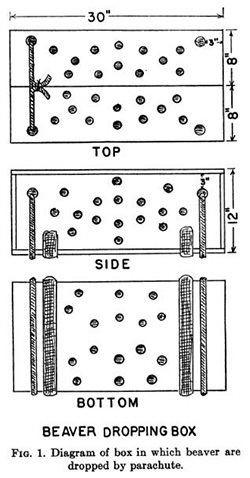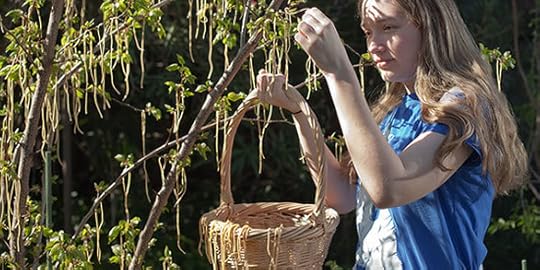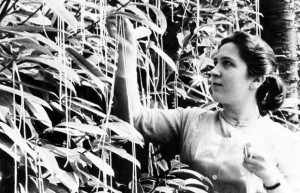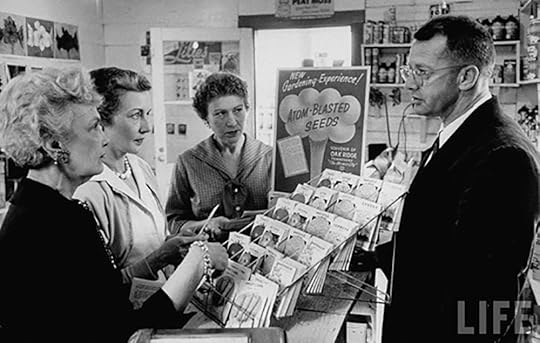Ripley Entertainment Inc.'s Blog, page 419
April 4, 2017
CARTOON 04-04-2017
April 3, 2017
Idaho Relocated Beavers By Parachuting Them From Planes
Featured in Ripley's Believe It or Not!

I’ve thought long and hard about exactly how to say this delicately, but I haven’t come up with anything, so I’m just going to say it. A government agency in America once dropped beavers out of a plane!
In a day when PETA will sue or protest if you so much as look at an animal wrong, it’s unbelievable to me that someone could have once just tossed animals out of a plane with impunity.
Eager Beavers
Maybe the real story isn’t as bad as all that sounds, but it’s still jaw-dropping.
The year was 1948. It was three years past the end of WWII, and people were starting to migrate into the beautiful area of Payette Lake in McCall Idaho.
In typical human fashion, they didn’t stop to consider the natives, in this case, the beaver population.
It didn’t take long for the residents of Payette Lake to figure out that living with busy beavers wasn’t going to be easy, so they decided the best bet was to move them to a new habitat.
Relocation
The questions for Idaho Fish and Game were where and how to move the little guys. Luckily, Elmo Heter worked in the department at the time, and he had experience with the critters, making him the closest thing to an expert the government had.
Heter knew that Chamberlain Basin was the perfect spot for the beavers. But the aspects of the basin that made it such an ideal destination (it’s remoteness and dense vegetation) also made it complicated to get the beavers to their new home in the first place. There are no roads leading into the basin, so cars were out of the question.
They might have packed the animals in boxes and strapped them to donkeys, but apparently beavers and donkeys don’t mix.
Horses and mules become spooky and quarrelsome when loaded with a struggling, odorous pair of live beavers.
Which left them with the only logical solution: drop the beavers from planes.

There are beavers in those boxes!
Geronimo
 Heter knew there was a surplus of parachutes left over from WWII. The plan seemed to be coming together. Heter could get the beavers out of the community and move them into a place where they could be happy and do some real good, all while getting rid of the parachutes too.
Heter knew there was a surplus of parachutes left over from WWII. The plan seemed to be coming together. Heter could get the beavers out of the community and move them into a place where they could be happy and do some real good, all while getting rid of the parachutes too.
So he designed a box that would fit a beaver and open upon impacting the ground. Then he tested it. First, he used weights, and then he found a male beaver, named him Geronimo, and started regularly dropping him from a plane.
Poor fellow! He finally became resigned, and as soon as we approached him, would crawl back into his box ready to go aloft again.
Once he was confident the plan would work, Heter made Geronimo the first official transplant and sent three female beavers with him.
Thereafter, 76 more of the little critters followed him along. All but one of the skydivers survived the trip and went on to work wonders for the natural habitat of the basin.
Say what you will about the craziness of Heter’s plan; the fact is it worked. And now we can all sit back and marvel at the fact that back in the 1940s, it rained beavers over Idaho.
Source: Idaho Relocated Beavers By Parachuting Them From Planes
Space Superstitions Practiced by Rocket Scientists
Featured in Ripley's Believe It or Not!

You wouldn’t think that the world’s foremost scientific agency would be very superstitious, but NASA has some long-standing traditions that they live and breathe by.
Before every launch from the Kennedy Space Center, astronauts eat a meal of steak, eggs, and cake, no matter the hour, and must play poker until the commander loses. They typically also bring along a stuffed animal. Not only is the plush considered lucky, but its fluffy body is a safe enough object to signal when gravity shifts and objects start floating.

Not Just Astronauts
Launchpad engineers believe it’s bad luck for astronauts to see the rocket before launch day, and take great measures to ensure none of the spacemen see their ride during the sometimes days-long journey to the launch pad.
Back at mission control, every shuttle launch was celebrated by a round of baked beans. What started as a single crockpot prepared by test director Norm Carlson, quickly grew into over 60 gallons consumed by the team and dignitaries after every launch.

Launch Bean Recipe
Put 6 lbs. of dried great northern beans in an 18-quart electric cooler.
Cut 10 lbs. of smoked ham into cubes.
Add ham and ham bones to beans.
Add 1/2 shaker of lemon pepper.
Add 3 lbs. chopped onions.
Add two stalks chopped celery.
Add one tsp. liquid smoke.
Cover with water and cook for at least 8 hours.
Enjoy!
Cosmonaut Traditions
In typical fashion, cosmonauts have some strange space superstitions of their own. Every single person launched into space from Baikonur Cosmodrome in Kazakhstan has peed on a bus tire just before take-off. This unPEElievable tradition started after Yuri Gagarin—the first man to orbit the Earth—took an emergency pit stop on the bus tire in 1961. The mission’s success has rooted the act forever in Russian history.
Female cosmonauts are not required to do their business then and there, but most bring a pre-prepared vial along to pour on the tire.

CARTOON 04-03-2017
April 2, 2017
CARTOON 04-02-2017
April 1, 2017
CARTOON 04-01-2017
March 31, 2017
Delectable Spaghetti Trees of Switzerland
Featured in Ripley's Believe It or Not!


Delicate spaghetti harvesting
On April 1, 1957, the BBC News television program, Panorama, produced a featured story on the Swiss spaghetti farmer.
It was a detailed, 3-minute segment that chronicled the first spaghetti harvest of the year.
Last two weeks of March is an anxious time for the spaghetti farmer. − Panorama
The piece explains that spaghetti farming is a family affair in Switzerland:
“Spaghetti cultivation here is Switzerland is not, of course, carried out on anything like the tremendous scale of the Italian industry[…]Many of you, I am sure, will have seen pictures of the vast spaghetti plantations of the Po valley.”
 The biggest hoax that any reputable news establishment ever pulled
The biggest hoax that any reputable news establishment ever pulledThis incredible news story was an April Fool’s Day prank. Much to my dismay, spaghetti does NOT grow on trees. However, the ever gullible public bought the story- hook, line, and sinker.
Panorama is a reputable news show. Couple the show’s reputation with the segment narrated by a respected broadcaster, Richard Dimbleby, and you have yourself a winning recipe for one of the greatest media hoaxes in history!
In 1957, spaghetti was not widely prevalent in the UK, which also added to the stories believability.
The idea for the story came about when a cameraman for the show remembered how his teachers teased his class for believing spaghetti grew on trees.
Segment highlights
There are many hilariously memorable quotes from the piece. Here are a few of our favorites:
“Another reason why this might be a bumper year lies in the virtual disappearance of the spaghetti weevil, the tiny creature whose depredations have caused much concern in the past.”
“Many people are often puzzled by the fact that spaghetti is produced at such uniform length, but this is the result of many years of patient endeavor by plant breeders who succeeded in producing the ‘perfect spaghetti.'”
When viewers called the BBC to ask how to grow their own spaghetti tree, they were told to “Place a sprig of spaghetti in a tin of tomato sauce and hope for the best.”
Watch for yourself!
You may want to scrub past the first 30 seconds of credits.
Atomic Gardening in the 1950s
Featured in Ripley's Believe It or Not!

Atomic Gardening began as a campaign to promote the peaceful use of fission energy after the end of World War II.
Coming out of an extended period of conflict that only ended by using the most powerful and destructive weapons ever wielded by humankind, Atoms for Peace was an initiative to harness the power of the atom to help humanity thrive in the future.
They set up a series of Gamma Gardens across the globe, including the US, Russia, and Japan that used cobalt isotopes as a source of radiation.

Atomic gardens used radiation to induce useful mutations in plants. Scientists arranged typical gardens in a circle, with different levels of radiation reaching plants from the center.
Plants close to radiation sources usually died, and mid-ranged plants would develop tumors and growths. At the far reaches of the garden, plants typically survived, but with significant mutations.
Successes
Ideally, some plants might develop mutations that could prove beneficial, and then be bred into normal plants.
A peppermint plant resistant to particular strains of wilt, for example, was bred using atomic gardening.
Irradiated seeds became the “in” seeds for farmers, and “Atomic Energized” seeds were even marketed to housewives to conduct their own atomic gardening experiments at home.

Ruby-red grapefruit, rice, wheat, pears, cotton, peas, sunflowers, bananas and countless other produce owe their present-day heartiness to the genetic modification afforded by atomic gardening.

Atomic Gardening Today
Modern genetic engineering has become far more precise using modern science techniques and gene sequencing technology, and only one large atomic garden remains.
The Institute of Radiation Breeding in Japan has the trademark pie-shape of gamma gardens. The compound stretches over 300 feet across, and 25-foot tall shielded wall surrounds the entire garden to contain spill-off radiation.
The lab is currently breeding for fungus resistance and fruit color.

Source: Atomic Gardening in the 1950s
CARTOON 03-31-2017
March 30, 2017
CARTOON 03-30-2017
Ripley Entertainment Inc.'s Blog
- Ripley Entertainment Inc.'s profile
- 52 followers










